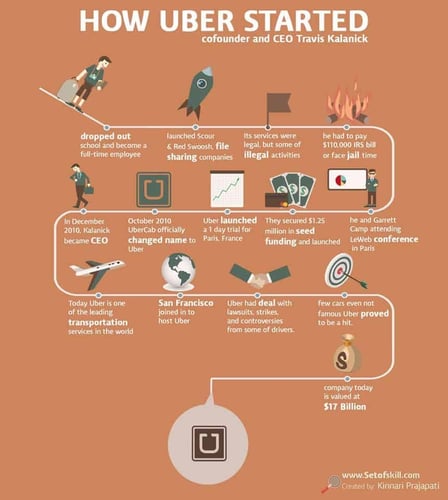Table of Contents
How do average people fundamentally reshape a global multi-billion-dollar industry?
In Uber's case, the answer is "by driving the same cars they already have."
In this Uber case study, we will find out how they ascended to the heights of success and navigated through difficult waters along the way. We'll see how they've built a sustainable brand that continues to succeed in a challenging industry.
Uber was one of the first companies to embrace and define "the sharing economy" concept. In so doing, it empowered consumers and entrepreneurial individuals to take control of for-hire transportation.
It is, in short, one of the most iconic technology companies in modern history.
That success didn't happen overnight or without a lot of strategic planning and effort.
Uber is not a mere beneficiary of good luck or positive economic forces beyond their control. They are a perfect example of how a brand can be disruptive, transformative, and even sustainable.
Innovation in the Driver's Seat
Innovation was the driver behind Uber's initial success. This was evident in its unique premise: hail a ride from anywhere using a smartphone.
It is easy to forget that only a few short years ago, this wasn't possible. At best, one might call a ride in from a local taxi or shuttle company, wait in the taxi line at the airport, or hail a cab on the side of the street.
Uber's entry into the opaque world of ride-for-hire also allowed it to define innovation as its primary driver early on. The company would, its management said, define itself as a technology company and not as some kind of new taxi enterprise.
Again, a few years ago, this was unthinkable. Uber was a completely new product in a world where people had to wave down a ride from the side of the street. Uber's product put the power of transportation into the hands of riders through their smartphone.

Embracing Disruption
As the company grew and ran into regulatory barriers erected to support the traditional for-hire transportation industry, such as taxis and limousines, it decided to embrace the controversial role of industry disruptor.
How, though, could Uber win against the myriad taxi regulations in major cities, which prevented them from doing things like picking up and dropping off at airports?
As Shark Tank investor Kevin Harrington pointed out in Forbes, the answer was in mobilizing customers to their cause. Uber was able to identify that many of its customers weren't happy with the existing state of affairs in the transportation industry.
These customers wanted something better and became Uber's core base. They then became advocates for the company in various forums as it fought against old regulations. Uber was smart to identify and cultivate these customers early on.
By making customer convenience and service a priority, Uber took the role of "disruptor" and turned it into a part of the company's image and brand. They joined a broader socioeconomic movement towards changing old industries in ways that benefited consumers.
Uber, of course, also had to create a framework of lobbyists and other professional policy advocates. They began spending millions of dollars in places like New York City. These fights continue because regulated taxis haven't given up trying to keep Uber from invading their turf.
By and large, however, Uber has won – and in the process, made the innovation of changing an old industry part and parcel of what it represents to consumers.
Navigating Tough Waters
No Uber case study would be complete, or accurate, without documenting Uber's challenges over the past couple of years.
In February 2017, former Uber employee Susan Fowler, an engineer, made a blog post heard round the world. On her blog, she described a toxic culture at the company where sexual harassment was rampant and managers cannibalized each other.
Her post received so much attention that Uber decided to respond by having the law firm Perkins Coie do an investigation into her allegations.
The CEO and co-founder of Uber, Travis Kalanick, began facing scrutiny over Uber's company culture.
The company recognized a crucial if simple truth: to maintain a sustainable brand long-term, Uber had to be honest about what it stood for. Was it a cutting-edge, progressive company, as it attempted to posture itself? The brand teetered on the brink of outright hypocrisy, if not total disaster.
If it was the brand that Kalanick had long said that it was, then he had to go. Kalanick, along with Uber's management, recognized this. There were numerous other personnel casualties of Uber's very public self-reflection.
The most noteworthy demise, however, was the toxic culture threatening the long-term viability of the company. Out of the ashes of its former self, Uber decided to undergo a massive effort to restore its image and set itself up for the future.
Table of Contents
Rebranding for the Future
Uber took what could have been its defeat and turned it into an opportunity. The new CEO made a point of listening to employees and driving that principle deep into the heart of a new corporate culture.
Some Uber executives even go the extra mile to participate as normal Uber drivers and experience what Uber's drivers experience. The importance of getting one's hands dirty is a part of the refreshed culture. Executives now attempt to bridge the gaps between drivers and the employees at the very top.
It also embarked on a major rebranding intended on capturing an accessible, progressive style that reflected the best of the company and communicated credibly with consumers. Uber recognized that design was crucial to the customer experience.
This included not only practical matters, such as the kind of typeface used, but also larger questions such as the tone of voice applied to its marketing and communication efforts.
Uber is not done with its rebranding effort, which included a massive initial public offering (IPO) in May of 2019. Uber's entry into the stock market has been fraught with challenges. The company continues to lose money and investor confidence dwindles. The stock has had problems due to doubts about Uber's profitability, among other concerns.
However, the Uber brand continues to be strong and recognizable – an asset that is almost certain to continue.
Lessons of the Uber Case Study
Uber is, in one sense, a wholly unique company whose success would seem hard to emulate.
After all, not everyone is in a position to create a new company that disrupts an entire industry and takes on regulators the world over en route to a multi-billion-dollar IPO.
On the other hand, many of the lessons that Uber provides apply to other companies and startups.
Uber's determination to focus on technology and innovation points to the importance of defining a clear brand strategy and messaging focus.
Their ability to embrace the role of disruptor offers hope to entrepreneurs tackling business norms and stale industry attitudes.
Hope can also be found in the company's ability to weather challenges to its very existence. Uber took what could have been a disastrous 2017 and parlayed it into fresh opportunities for the company that concluded with an IPO.
The final lesson of this Uber case study, then, appears to be determination: determination to strategize and plan with clarity and focus, determination to stick with it through thick and thin, and determination to right the ship when things get difficult.
Are You the Next Uber?
Uber's determination has proven, in many respects, to be the core value upon which its brand is most closely associated. It is this determination which also proves the greatest lesson for others in this Uber case study.
Do you have a great idea for a mobile or web app and want to emulate the success of Uber? We have experience helping some of the most credible and innovative firms in Australia and would love to partner with you to create more success.
Reach out to learn more!

Michael leads the UX/UI team at EB Pearls, bringing 30+ years of experience in interaction design and crafting digital products for Fortune 50 companies.
Read more Articles by this Author
